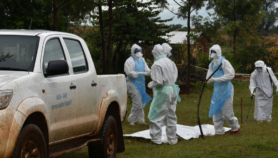By: Calvin Otieno
Send to a friend
The details you provide on this page will not be used to send unsolicited email, and will not be sold to a 3rd party. See privacy policy.
[NAIROBI] Road networks are strongly related to the spread of HIV-1 — the HIV subtype responsible for the AIDS pandemic — across Sub-Saharan Africa, a study confirms.
The study, published online in AIDS, says that the travel of hundreds of thousands of people by road across the continent daily has played a significant role in the distribution and spread of HIV-1.
SPEED READ
- Road networks across Sub-Saharan Africa have fostered spread of HIV
- New study maps spread at higher level of detail than ever before
- Adequate surveillance and health facilities should be put in place where new roads are planned
Researchers from the United Kingdom and United States mapped HIV-1 distribution patterns across Sub-Saharan Africa between 1998 and 2008 using molecular epidemiology data. Their work, which maps the data "at a finer level of detail than ever before", builds on prior local studies that "have shown that transport infrastructure and human mobility are strongly related to HIV spread in Africa, and are likely major driving forces".
Andrew Tatem, associate professor at the University of Florida, and lead author of the study, tells SciDev.Net that transport infrastructure and other geographic features can promote or inhibit goods and people’s movements but have also been linked to the spread of many kinds of diseases for many years — adding that this is not unique to HIV and not exclusive to Sub-Saharan Africa.
He adds that places with good transport infrastructure leads to more people accessing an area and this may lead to more exchange of HIV between those areas.
"Wherever people make trips they take pathogens with them, and the more they travel, the higher the chances that more pathogens will be carried and diffused to newer locations," he says. Tatem adds that while new, accessible and quality roads bring many benefits and convey infrastructural development, they also promote this movement of pathogens to new areas.
However, he says that the spread should not affect the development of infrastructure across Africa.
"What could be done is to ensure that adequate surveillance and health facilities providing prompt diagnosis and treatment are in place in areas where infrastructure development is planned."
Samoel Khamadi, a senior researcher at the Kenya Medical Research Institute’s Centre for Virus Research, says that major road networks are some of the worst "HIV hotspots" because of sex trade.
He says that the spread of HIV/AIDS through road networks should be "a wakeup call" for emphasising the importance of preventative measures. These could include awareness creation among people on the importance of safe sex and providing alternative livelihoods for sex workers.
This article has been produced by SciDev.Net’s Sub-Saharan Africa desk
References
AIDS doi:10.1097/QAD.0b013e328359a904 (2012)













